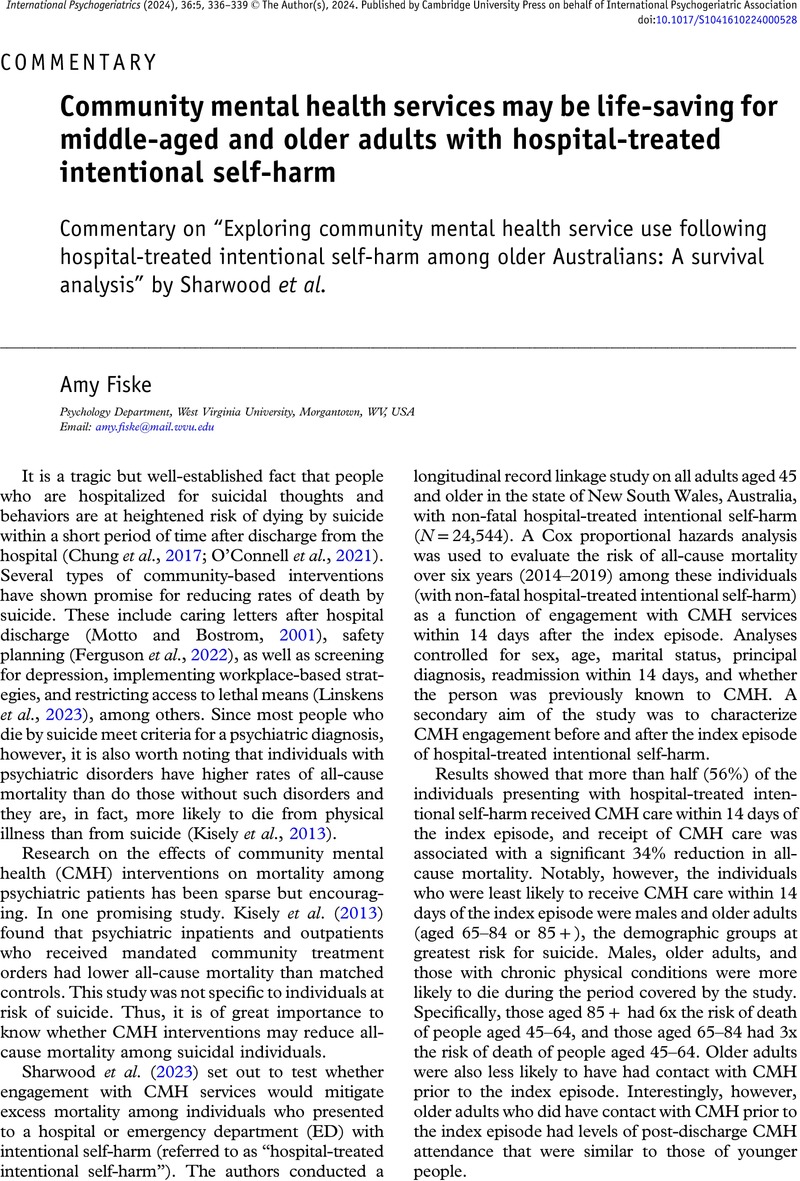No CrossRef data available.
Article contents
Community mental health services may be life-saving for middle-aged and older adults with hospital-treated intentional self-harm
Commentary on “Exploring community mental health service use following hospital-treated intentional self-harm among older Australians: A survival analysis” by Sharwood et al.
Published online by Cambridge University Press: 22 March 2024
Abstract
An abstract is not available for this content so a preview has been provided. Please use the Get access link above for information on how to access this content.

Information
- Type
- Commentary
- Information
- International Psychogeriatrics , Volume 36 , Special Issue 5: Issue Theme: Suicide in Older Adults , May 2024 , pp. 336 - 339
- Copyright
- © The Author(s), 2024. Published by Cambridge University Press on behalf of International Psychogeriatric Association
References
Bryan, C. J., Butner, J. E., May, A. M., Rugo, K. F., Harris, J. A., Oakey, D. N., Rozek, D. C., Bryan, A. B. O. (2020). Nonlinear change processes and the emergence of suicidal behavior: a conceptual model based on the fluid vulnerability theory of suicide. New Ideas in Psychology, 57, 100758. https://doi.org/10.1016/j.newideapsych.2019.100758
CrossRefGoogle ScholarPubMed
Calati, R., Ferrari, C., Brittner, M., Oasi, O., Olié, E., Carvalho, A. F., & Courtet, P. (2019). Suicidal thoughts and behaviors and social isolation: a narrative review of the literature. Journal of Affective Disorders, 245, 653–667. https://doi.org/10.1016/j.jad.2018.11.022
CrossRefGoogle ScholarPubMed
Chang, C.-C., Wu, C.-S., Tseng, H.-Y., Lee, C.-Y., Wu, I.-C., Hsu, C.-C., Chang, H.-Y., Chiu, Y.-F., Hsiung, C. A. (2022). Assessment of incident frailty hazard associated with depressive symptoms in a Taiwanese longitudinal study. International Psychogeriatrics, 34(1), 61–70. https://doi.org/10.1017/S1041610221000806
CrossRefGoogle Scholar
Chung, D. T., Ryan, C. J., Hadzi-Pavlovic, D., Singh, S. P., Clive Stanton, C., & Large, M. M. (2017). Suicide rates after discharge from psychiatric facilities a systematic review and meta-analysis. JAMA Psychiatry, 74(7), 694–702. https://doi.org/10.1001/jamapsychiatry.2017.1044
CrossRefGoogle ScholarPubMed
Ferguson, M., Rhodes, K., Loughhead, M., McIntyre, H., & Procter, N. (2022). The effectiveness of the safety planning intervention for adults experiencing suicide-related distress: a systematic review. Archives of Suicide Research, 26(3), 1022–1045. https://doi.org/10.1080/13811118.2021.1915217
CrossRefGoogle ScholarPubMed
Goldstein, J. L., & Godemont, M. M. L. (2003). The legend and lessons of Geel, Belgium: a 1500-year-old legend, a 21st-century model. Community Mental Health Journal, 39(5), 441–458.CrossRefGoogle ScholarPubMed
Jeste, D. V., Glorioso, D. K., Depp, C. A., Lee, E. E., Daly, R. E., Jester, D. J., Palmer, B. W., & Mausbach, M. T. (2023). Remotely administered resilience- and wisdom-focused intervention to reduce perceived stress and loneliness: pilot controlled clinical trial in older adults. American Journal of Geriatric Psychiatry, 31(1), 58–64. https://doi.org/10.1016/j.jagp.2022.07.006
CrossRefGoogle ScholarPubMed
Kandasamy, D., Platts-Mills, T. F., Shah, M. N., Van Orden, K. A., & Betz, M. E. (2018). Social disconnection among older adults receiving care in the emergency department. Western Journal of Emergency Medicine, 19(6), 919–925.CrossRefGoogle ScholarPubMed
Kisely, S., Preston, N., Xiao, J., Lawrence, D., Louise, S., Crowe, E. (2013). Reducing all-cause mortality among patients with psychiatric disorders: a population-based study. Canadian Medical Association Journal, 185(1), E50–E56. https://doi.org/10.1503/cmaj.121077
CrossRefGoogle ScholarPubMed
Linskens, E. J., Venables, N. C., Gustavson, A. M., Sayer, N. A., Murdoch, M., MacDonald, R., Ullman, K. E., McKenzie, L. G., Wilt, T. J., Sultan, S., (2023). Population- and community-based interventions to prevent suicide. Crisis-the Journal of Crisis Intervention and Suicide Prevention, 44(4), 330–340. https://doi.org/10.1027/0227-5910/a000873
CrossRefGoogle ScholarPubMed
Lutzman, M., Sommerfeld, E., & Ben-David, S. (2021). Loneliness and social integration as mediators between physical pain and suicidal ideation among elderly men. International Psychogeriatrics, 33(5), 453–459. https://doi.org/10.1017/S104161022000112X
CrossRefGoogle ScholarPubMed
McClelland, H., Evans, J. J., Nowland, R., Ferguson, E., & O’Connor, R. C. (2020). Loneliness as a predictor of suicidal ideation and behavior: a systematic review and meta-analysis of prospective studies. Journal of Affective Disorders, 274, 880–896. https://doi.org/10.1016/j.jad.2020.05.004
CrossRefGoogle ScholarPubMed
Motto, J. A., & Bostrom, A. G. (2001). A randomized controlled trial of postcrisis suicide prevention. Psychiatric Services, 52(6), 828–833.CrossRefGoogle ScholarPubMed
O’Connell, P. H., Durns, T., & Kious, B. M. (2021). Risk of suicide after discharge from inpatient psychiatric care: a systematic review. International Journal of Psychiatry in Clinical Practice, 25(4), 356–366. https://doi.org/10.1080/13651501.2020.1800043
CrossRefGoogle ScholarPubMed
Okolie, C., Dennis, M., Thomas, E. S., & John, A. (2017). A systematic review of interventions to prevent suicidal behaviors and reduce suicidal ideation in older people. International Psychogeriatrics, 29(11), 1801–1824. https://doi.org/10.1017/S1041610217001430
CrossRefGoogle ScholarPubMed
Rudd, M. D. (2006). Fluid vulnerability theory: A cognitive approach to understanding the process of acute and chronic risk. In Ellis, T. E. (Eds.), Cognition and suicide: Theory, research, and therapy (pp. 355–368). American Psychological Association.CrossRefGoogle Scholar
Sharwood, L. N., Waller, M., Draper, B. M., & Shand, F. (2023). Exploring community mental health service use following hospital-treated intentional self-harm among older Australians: a survival analysis. International Psychogeriatrics. https://doi.org/10.1017/S1041610223000959
CrossRefGoogle ScholarPubMed
Wang, F., Gao, Y., Han, Z., Yu, Y., Long, Z., Jiang, X., Wu, Y., Pei, B., Cao, Y., Ye, J., Wang, M., Zhao, Y. (2023). A systematic review and meta-analysis of 90 cohort studies of social isolation, loneliness and mortality. Nature Human Behavior, 7(8), 1307–1319.CrossRefGoogle ScholarPubMed

